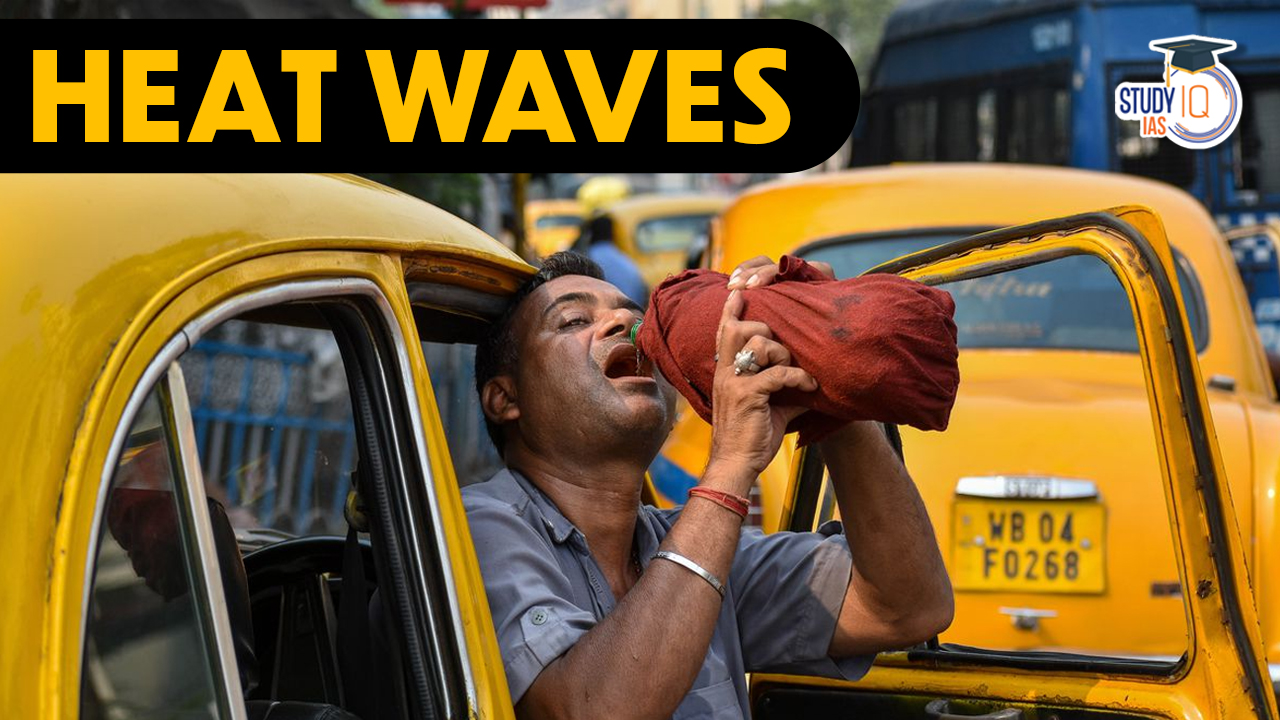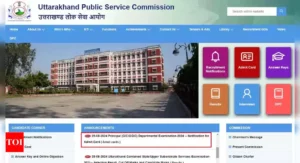Table of Contents
Context: A sweltering heatwave has claimed the lives of several people in Uttar Pradesh and Bihar over the last few days.
What are Heatwaves?
- Heat waves are extreme events in which hot temperature in summer months persist for a relatively long period of time.
- In India, heatwaves typically occur between March and June, and in some rare cases even extend till July.
- Criterion for declaring a heatwave in India (as per IMD):
| Heat wave is considered if maximum temperature of a station reaches at least 40°C or more for Plains and at least 30°C or more for Hilly regions. | |
| Based on Departure from Normal | Based on Actual Maximum Temperature |
|
|
| Note: If above criteria met at least in 2 stations in a Meteorological sub-division for at least two consecutive days, then the heatwave will be declared on the second day. | |
| Criterion for describing a heatwave in coastal stations: When maximum temperature departure is 4.50C or more from normal, Heat Wave may be described provided actual maximum temperature is 370C or more. | |
Causes of Heatwaves
- High-pressure systems: Heatwaves often occur when a high-pressure system becomes stationary over a region. High-pressure systems promote sinking air, which inhibits cloud formation and prevents the release of heat through convection. As a result, the air near the surface becomes trapped and warms up, leading to prolonged periods of high temperatures.
- Drought and lack of precipitation: When the soil is dry, more of the sun’s energy goes into heating the air rather than evaporating moisture from the ground. This leads to increased temperatures and further exacerbates the heatwave conditions.
- Role of global warming: The global warming is poised to make heat waves longer, more intense, and more frequent.
- The IPCC’s 6th Assessment Report projects that, for 1.5°C of global warming, there will be increasing heat waves, longer warm seasons and shorter cold seasons.
- The report also predicted that India will suffer more frequent and intense heat waves as well as increased precipitation in the remaining decades of the 21st century.
- Heatwaves have increased in frequency in recent decades due to global warming. 2022 was the fifth warmest for India since 1901.
- Urbanization: Rapid urbanization and the growth of concrete jungles in cities can lead to the phenomenon known as the “urban heat island effect.”
- Urban areas with high population density, buildings, and concrete surfaces absorb and retain more heat, leading to higher temperatures, particularly during heatwaves.
- El Nino Effect: During an El Nino event, the warming of the eastern Pacific Ocean can affect global weather patterns, causing changes in temperature, rainfall, and wind patterns around the world.
- The summer of the year 2023 is predicted to be excessively hot because of the earlier-than-expected occurrence of El Nino event.

Impacts of Heatwaves
- Agriculture and food production: Prolonged high temperatures can damage crops, reduce yields, and even lead to crop failures. Heat stress can also affect livestock, resulting in reduced productivity and increased mortality rates.
- In 2022, a heatwave in March curtailed India’s wheat production to 100 million tonnes against local consumption of 103.6 million tonnes.
- Human health: Heat-related illnesses like heatstroke, dehydration, and heat exhaustion can occur, and in severe cases, they can be fatal. The combination of high temperatures, increased air pollution, and heat-related illnesses can put a strain on healthcare systems.
- India saw a 55% increase in deaths due to extreme heat between 2000-2004 and 2017-2021, found the Lancet research.
- Natural ecosystems: Increased temperatures can lead to the degradation of habitats, changes in species distribution and behavior, and increased vulnerability to pests and diseases. Heatwaves can also contribute to the bleaching and death of coral reefs and affect marine ecosystems.
- During the summer of 2015-2016, a prolonged and intense heatwave in the Great Barrier Reef, off the coast of Australia, resulted in widespread coral mass bleaching.
- Infrastructure strain: Increased demand for air conditioning and cooling systems can overload power systems, leading to blackouts or power outages. Heat can also cause the expansion of materials, leading to road and pavement damage.
- Water resources: Higher temperatures increase evaporation rates, leading to the drying up of rivers, lakes, and reservoirs. This can have consequences for drinking water supplies, irrigation for agriculture, and aquatic ecosystems.
- Economic losses: The International Labour Organization (ILO) projects that economic losses related to heat stress will rise from US$280 billion in 1995 to $2.4 trillion in 2030, with lower-income countries seeing the biggest losses.
Heatwave Mitigation and Adaptation Strategies
- Climate change mitigation: The most effective way to avoid the negative impacts of heatwaves is to mitigate the climate change by reducing GHG emissions and minimize the rise in global mean temperatures.
- For example, shifts towards cleaner energies like solar energy, wind energy etc. will not only reduce GHG emissions, but will also reduce localized air pollution and heat island effects within the cities.
- Need to build resilience: A set of strategies to build resilience to extreme heat, “Resilience Strategies for Extreme Heat.” Some strategies include:
- Creating heat preparedness plans, identifying vulnerable populations, and opening cooling centers during extreme heat.
- Installing cool and green roofs and cool pavement to reduce the urban heat island effect.
- Planting trees to provide shade and to cool the air through evapotranspiration.
- Pursuing energy efficiency to reduce demand on the electricity grid, especially during heat waves.
- Technological adaptations: Strengthening heat resilience and early-warning capabilities may yield disproportionate economic benefits.
- Contingent and temporary adaptations: Such as converting public spaces into cooling centers, deploying public evaporative cooling systems, and expanding emergency service availability.
- Urban greening: It was identified as key adaptation strategy with co-benefits that include emissions reductions, energy savings, better health outcomes, reduced urban heat island effect, and water savings.
- Community engagement and education: Engaging communities and promoting public education and awareness about heatwaves can encourage individuals to take preventive measures and adapt to changing climate conditions.
Critical Assessment of India’s Heat Action Plans
What are Heat Action Plans (HAPs)?
- HAPs are India’s primary policy response to economically damaging and life-threatening heatwaves.
- They prescribe a variety of preparatory activities, disaster responses, and post-heatwave response measures across state, and districts to decrease the impact of heatwaves.
- For example: Ahmedabad’s Heat Action Plan
- In the backdrop of 2010’s devastating heatwave, Ahmedabad had launched India’s first heat action plan in the year 2013.
- The heat action plan builds resilience to extreme heat events through public awareness and community outreach, early warning systems, capacity building among healthcare professionals, and promoting adaptive measures to reduce heat exposure.
- An important component of the heat action plan includes ‘cool roofs’ — coatings or materials that reflect sunlight and absorb less heat.
Centre for Policy Research (CPR)’s Report on India’s Heat Action Plans (HAPs)
- The Centre for Policy Research has released a report titled ‘How Is India Adapting to Heatwaves? An Assessment of Heat Action Plans with Insights for Transformative Climate Action’.
- The Centre for Policy Research is a Delhi based non-profit public policy think tank.
- The report assessed 37 heat action plans across 18 states in order to understand how well-prepared India is to deal with heat waves.
- Key findings of the report include:
- Not built for local context: The report said that most heat action plans are not built for local context and have an oversimplified view of hazards. Only ten out of 37 HAPs reviewed seem to establish locally-defined temperature thresholds to declare heatwaves.
- Inadequate targeting of vulnerable groups: Only two of 37 HAPs explicitly carry out and present vulnerability assessments. This leaves the implementer with little data on where to direct their scarce resources and could lead to poor targeting.
- Underfunded: Only 11 of 37 HAPs discuss funding sources. Of these, eight asked implementing departments to self-allocate resources, indicating a serious funding constraint.
- Weak legal foundations: The report noted a lack of legal authority in heat action plans, leading to reduced bureaucratic compliance with plan instructions.
- Insufficiently transparent: The report said that there is no national repository of heat action plans, very few plans are listed online, and it is unclear whether the plans are being updated periodically.
- Recommendations of the report include:
- Inclusion of climate projections, and localisation of the heat hazard definition.
- Incorporating vulnerability assessments and shift to more holistic risk assessments.
- Integrating heat action plans with existing schemes and linking them to national climate funding mechanisms, while also exploring the inclusion of heat waves as a notified disaster to obtain funds for disaster preparedness.
- Linking the heat action plans with the legal structure to ensure better disaster management and governance of the environment.
- Creation of a national repository of heat action plans housed in the National Disaster Management Authority (NDMA) and conducting publicly accessible external evaluations of the plans’ performance.


 UKPSC Lower PCS Recruitment 2024: Exam D...
UKPSC Lower PCS Recruitment 2024: Exam D...
 India’s First Full-Stack Quantum Compu...
India’s First Full-Stack Quantum Compu...
 World Liver Day 2025, Theme, History, Ce...
World Liver Day 2025, Theme, History, Ce...





















